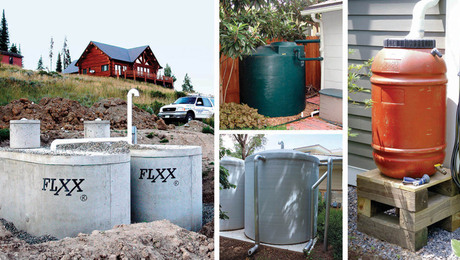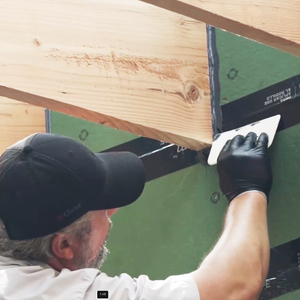I am renting a Cat 953 Track Loader soon to dig my foundation, driveway and knock over some trees…
Anyways, it weighs 32,000 lbs, and should dig pretty fast. The house will be build sorta straddling an abandoned railroad bed berm, so I need a hole where my house goes, and to put that fill where the garage will be. The railroad berm (my future fill material) is made of roughly 2′ square rocks, clay, and gravel–pretty solid stuff. Now for the question:
Can I pour my garage footers on this newly moved fill if I drive over it lots with this huge loader (in 1′ lifts, paying attention, no organic material etc) or do I need to dig 9′ deep footers and lay all that block?
The deep footers would be a real waste of materials and time, but I don’t want any unplanned settling…
Does anyone know the standards for compacting fill, tips, techniques? Experience?


















Replies
Brian,
One of the reasons farmers use track drives (Cats) is to minimize compaction.
SamT
Thanks Sam - I'd have to look at the Cat sites to get a psi figure - my neighbor brags his Bobcat track machine is 4psi, but I'm not letting him drive over my foot! I really don't want to risk cracks etc, but wanted to get a feel for the "standard" way folks are handling this type of situation.
Do I need to rent a sheepsfoot roller too?
Edit - I checked the web, Cat 953C loader is 9.5 psi - so that is 1368 lbs/square foot - that sounds like a lot of weight...?
Edited 4/6/2005 12:22 am ET by Brian
You need to consult with a soils engineer for this one.
I built a large building on a lot that had a LOT of fill (converted low-land to usable-land with clay from a road project). We compacted and compacted and compacted.. and when it was all said and done... we compacted again. When the testings would come back... the tests were as high as the engineering firm had ever seen.
We would have been ok... except when we drilled a couple of samples to assure the footings (purely luck... we got a tip on a potential problem from a neighboring owner)... we ran into a sand-seam. We ended up having to dig below the sand-seam to reach solid ground.
We dug the holes and filled it with K-crete (on suggestion of the engineer). MUCH MUCH cheaper than what a foundation of that height would have cost. Brought it up to the correct elevation... let set-up... poured footings... foundation... building... voilà!
I had a chance to see the interior of the building the other day. Keep in mind... there are huge open expanses inside... and there is not a crack in the ceiling anywhere (drywall; hard-knockdown). I wasn't really surprised... but I figured while I was there... I would check it out.
It's just a thought/idea... but you definitely want to check with a good soils engineer before doing anything.... it is worth the paltry amount you will pay for testing and advice.
Just running over it with a track will not do it, IMO. You'll need to get the vibratory compaction that can be achieved with a compactor.
Compaction is not so much a matter of weight as it is consolidation by vibration. Lots of other stuff involved, like soil types, mixes of soil, and moisture content.
Get a engineer to do an evaluation and rcommendations for your site. It will be cheaper in the long run, than using the wrong equipment to get the wrong results.
Dave
I checked the web, Cat 953C loader is 9.5 psi - so that is 1368 lbs/square foot - that sounds like a lot of weight...?
I get twice than much with my loaded truck, which would be my only machine I'd consider for compaction, and I wouldn't trust it there.
Time for the engineer.PAHS Designer/Builder- Bury it!
"...Cat 953C loader is 9.5 psi - so that is 1368 lbs/square foot - that sounds like a lot of weight...?"
Not really. Around here they typically require footers to be on 2,000 PSF soil. You aren't much over halfway there.
I'm not generally a fan of the "hire an engineer" line. But I think it's definitely the thing you need to do here.
What you're trying to do is unconventional and risky at best. Can you imagine what it will cost you to fix it if you're wrong?
Join the Army. Visit exotic places, meet interesting people, then kill them.
Brian,
It's not only the compaction, but the material. I know granular fill cost money, trucking, cost of material, placement, tamping, and grading. It all part of the final product.
No, you can't put footers on fill you just drive over with heavy machinery. Even when the proper engineered material is used and the proper compaction equipment is used the material must be placed and compacted in layers of half a foot or so. If you try to build on anything less than properly compacted material your foundation will crack badly.
Spend a few hundered bucks for a soils engineer. Trying to pinch pennies on the foundation will only get you burned.
Thanks all, I think I have my answer...
Brian
as a soil/concrete engineer, there is nothing I can add to above statements. they are all true. so I,m staying quiet.
This summer I had an excellent learning experience in this topic. Although our house was built on undisturbed soil there was no easy way to avoid putting the footings for the entryway on fill. These were proper 2'x2'x8" footings with an 8" pier projecting upward. So we pounded the sh*t out of the fill in 1' lifts with a 500lb compactor, drove back and forth with the excavator, and watered the fill as we went. Still, about a month after the entry was built I noticed that it had sagged away from the house about 2" in 10'. I had to jack it up off the piers and insert shims.
I will never question the need to build on undisturbed ground again.
Scott.